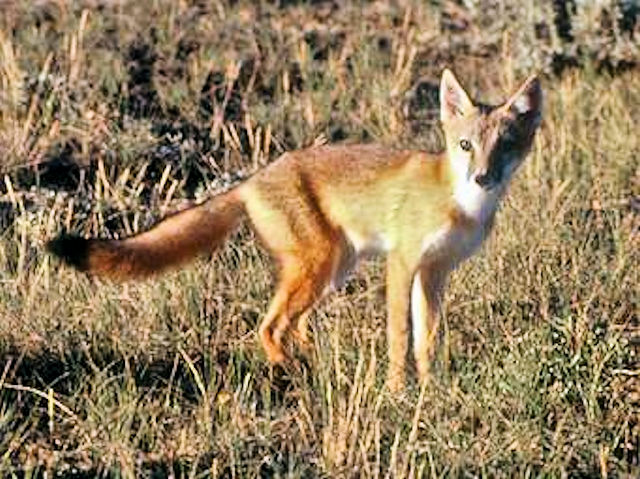It also lives in Manitoba, Saskatchewan and Alberta in Canada. It is closely related to the kit fox and the two species are sometimes known as subspecies of Vulpes velox because hybrids of the two species occur naturally where their ranges overlap.
The fur of the swift fox consists of a thick undercoat sparsely covered with longer guard hairs. The fur serves not only to keep the fox warm through cold nights but also insulates it from heat during the day. The soles of the kit fox´s feet are also covered with hair to protect them from hot desert sands. The coats are pale yellow-beige and grey to blend in with the desert grass. A pale underbelly, dark spots on either side of its nose, and a black tail tip are also characteristic. Like the arctic fox, the swift fox has heavily pigmented eyes to protect them from the sun´s glare.
Total length: Approximately 31 inches of which its tail makes up about 11 inches and stands about 12 inches tall at the shoulder.
Weight: 4 to 5.5 pounds.
Habitat: The swift fox lives primarily in short-grass prairies and deserts. They form their dens in sandy soil on open prairies, in plowed fields, or along fences. It is native to the Great Plains region of North America, and its range extends north to the central part of Alberta, Canada, and south to Texas. It reaches from western Iowa to Colorado, Kansas, Wyoming, Nebraska, and Montana.
Food Habits: Like most canids, the swift fox is an omnivore, and its diet includes rabbits, mice, ground squirrels, birds, and insects as staples. Grasses and fruits round out its diet. However, like any efficient forager, the swift fox takes advantage of seasonal foods. During the summer, adults eat large amounts of insects, including beetles and grasshoppers, and feed their young with larger prey items. Deer and other carrion killed by other animals may also be important food sources.
Life History: It is primarily nocturnal, spending only evenings and nighttime above ground in the summer. Daytime activities are usually confined to the den, but it has been known to spend the warm midday period above ground during the winter. The swift fox is more heavily dependent on its den than most North American canids, using them as shelter from predators. These dens are usually underground burrows that are 6 to 12 feet in length. It has been known to run very fast, at speeds of over 30 mph or up to 40 mph. The coyote is the swift fox's main predator, but often chooses not to consume the swift fox. Other predators include the badger, golden eagle, and bobcat.
 Description
Description
The swift fox has a dark, grayish, tan
coloration that extends to a yellowish tan color
across its sides and legs. The throat, chest,
and belly range from pale yellow to white in
color. Its tail is black-tipped, and it has
black patches on its muzzle. Its ears are
noticeably large. It is about 12 inches in
height, and 31 inches long, measuring from the
head to the tip of the tail, or about the size
of a domestic cat. Its weight ranges from around
five to seven pounds. Males and females are
similar in appearance, although males are
slightly larger.
Reproduction
The adult swift fox's breeding season
varies with region. In the northern United
States, it mates between January and March with
pups born in April and early May. The male swift
fox matures and may mate at one year, while the
female usually waits until her second year
before breeding. Adults live in pairs, and
although some individuals mate for life, others
choose different partners each year. Gestation
takes around 50 days, and one to eight kits are
born.
Pups develop quickly, occasionally reaching sexual maturity within a year. Swift fox pups are weaned by 6 or 7 weeks and emerge from dens in June or early July. Adult size is generally reached by early fall when pups are 4 to 5 months old.
 Juvenile swift foxes
disperse in fall or winter. Juvenile swift foxes
typically disperse an average of 6 to 9 miles.
Juvenile swift foxes
disperse in fall or winter. Juvenile swift foxes
typically disperse an average of 6 to 9 miles.
Unlike red foxes, breeding pairs of swift foxes have been known to maintain contact with each other all year round. Males have also been known to occasionally mate with more than one female in one season.
The swift fox only has one litter annually, but may occupy up to thirteen dens in one year, moving because prey is scarce or because skin parasites build up inside the den. Sometimes it makes other burrows from other bigger animals, even though it is completely capable of digging one on its own. Pups are born in the den and typically remain there for approximately one month. A newborn pup's eyes and ears remain closed for ten to fifteen days, leaving it dependent on the mother for food and protection during this time. It is usually weaned around six or seven weeks old and remains with its parents until fall. Recent research has shown that social organization in the swift fox is unusual among canids, since it is based on the females. Females maintain territories at all times, but males emigrate if the resident female is killed or removed.
The swift fox usually lives 3–6 years, but may live up to 14 years in captivity.




